The global AI in environmental sustainability market is forecasted to grow from USD 19.8 billion in 2025 to approximately USD 120.8 billion by 2035, recording an absolute increase of USD 100.92 billion over the forecast period. This translates into a total growth of 508.8%, with the market forecast to expand at a compound annual growth rate (CAGR) of 19.8% between 2025 and 2035. The market size is expected to grow by nearly 6.09X during the same period, supported by increasing environmental awareness, growing adoption of AI technologies for sustainability solutions, and expanding government initiatives for environmental protection and climate action.
Between 2025 and 2030, the AI in environmental sustainability market is projected to expand from USD 19.8 billion to USD 48.90 billion, resulting in a value increase of USD 29.07 billion, which represents 28.8% of the total forecast growth for the decade. This phase of growth will be shaped by increasing government investments in environmental technology, expanding corporate sustainability initiatives, and growing adoption of AI-driven solutions for climate monitoring and resource optimization across global markets.
From 2030 to 2035, the market is forecast to grow from USD 48.90 billion to USD 120.8 billion, adding another USD 71.85 billion, which constitutes 71.2% of the ten-year expansion. This period is expected to be characterized by widespread deployment of advanced AI technologies for environmental applications, expansion of smart city initiatives, and development of comprehensive AI-powered sustainability platforms that integrate multiple environmental monitoring and optimization capabilities.

| Metric | Value |
| Estimated Value in (2025E) | USD 19.8 billion |
| Forecast Value in (2035F) | USD 120.8 billion |
| Forecast CAGR (2025 to 2035) | 19.8% |
Market expansion is being supported by increasing urgency of climate change action and growing recognition of AI technology potential to address environmental challenges through intelligent monitoring, prediction, and optimization systems that enable more effective resource management and environmental protection. Rising government investments in sustainable technology and environmental protection initiatives are creating substantial opportunities for AI-powered solutions that support policy objectives and regulatory compliance.
The expanding corporate sustainability commitments and ESG requirements are driving sustained demand for AI technologies that enable comprehensive environmental monitoring, carbon footprint reduction, and sustainable business practices across diverse industries. Growing availability of environmental data and advances in AI algorithms are facilitating development of sophisticated sustainability solutions that provide actionable insights for environmental decision-making and resource optimization.
The market is segmented by application, technology, end use, and region. By application, the market is divided into climate change mitigation, renewable energy optimization, waste management, water resource management, biodiversity & wildlife monitoring, precision agriculture, air quality monitoring, and natural disaster prediction & response. Based on technology, the market is categorized into machine learning, computer vision, natural language processing, predictive analytics, and reinforcement learning. In terms of end use, the market is segmented into government & public sector, energy & utilities, agriculture, transportation & logistics, and manufacturing. Regionally, the market is divided into North America, Europe, Asia Pacific, Latin America, and Middle East & Africa.
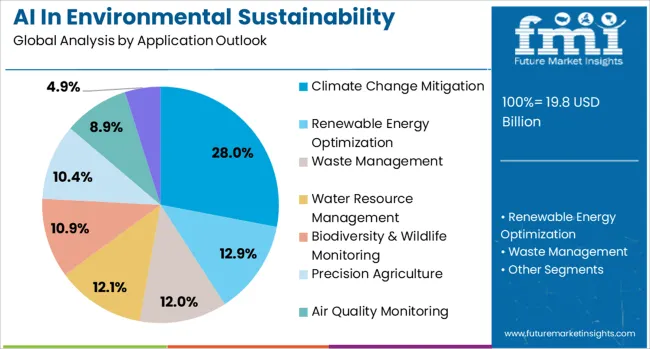
Climate change mitigation applications are projected to account for 28% of the market in 2025. This leading share is supported by urgent global climate action requirements and growing adoption of AI technologies for carbon emission monitoring, reduction strategies, and climate impact assessment across governmental and commercial sectors. AI-powered climate mitigation solutions enable comprehensive greenhouse gas tracking, emission reduction optimization, and climate risk assessment that support international climate commitments and corporate sustainability goals. The segment benefits from increasing climate policy requirements and substantial government funding for climate technology development.
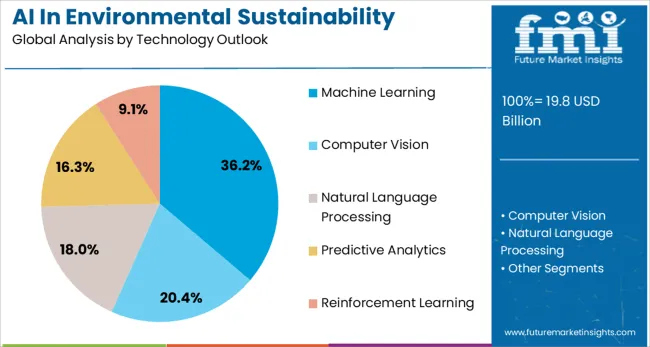
Machine learning technologies are expected to represent 36.2% of AI environmental sustainability demand in 2025. This dominant share reflects the fundamental role of machine learning algorithms in processing complex environmental data, identifying patterns, and generating predictive insights that enable effective environmental management and sustainability decision-making. Machine learning applications support diverse environmental use cases including resource optimization, predictive maintenance, and environmental risk assessment across multiple industries and applications. The segment benefits from continuous algorithm advancement and expanding availability of environmental datasets.
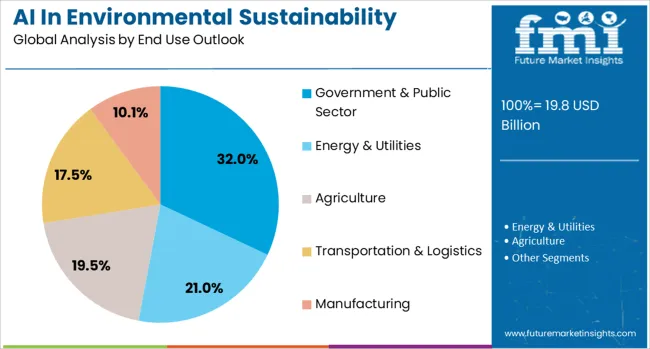
Government & public sector applications are projected to contribute 32.0% of the market in 2025, representing environmental agencies, municipal governments, and public institutions that utilize AI technologies for environmental monitoring, policy implementation, and sustainable resource management. Government applications drive substantial demand for comprehensive environmental AI solutions that support regulatory compliance, environmental assessment, and public health protection while enabling evidence-based environmental policy development and implementation.
The market is advancing rapidly due to increasing environmental awareness and growing urgency of climate action that drives adoption of advanced technology solutions. The market faces challenges including high implementation costs, data quality and availability issues, and need for specialized technical expertise that may limit adoption among smaller organizations. Innovation in AI algorithms and environmental sensor technologies continue to influence market development patterns.
The growing demand for real-time environmental insights is driving integration of AI technologies with IoT sensor networks and edge computing platforms that enable continuous monitoring and immediate response to environmental changes. Advanced IoT-AI integration provides distributed monitoring capabilities, reduces data latency, and enables automated environmental control systems that optimize resource utilization and environmental protection in real-time while reducing infrastructure costs and communication requirements.
Modern AI environmental solutions are evolving toward integrated platforms that combine multiple environmental monitoring and management capabilities with digital twin technologies for comprehensive sustainability modeling and optimization. Advanced sustainability platforms provide unified dashboards, predictive analytics, and scenario modeling that enable organizations to understand environmental impacts, optimize operations, and achieve sustainability targets through data-driven decision-making and automated optimization systems.
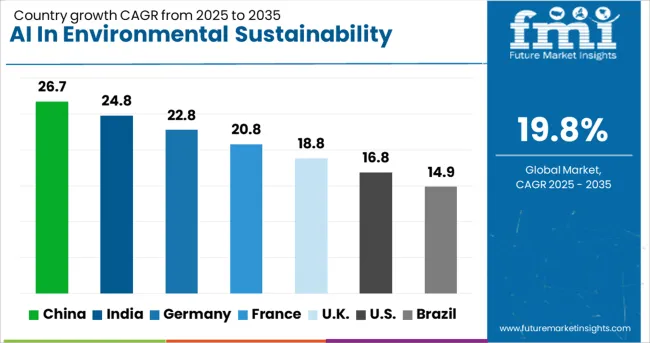
| Country | CAGR (2025-2035) |
| China | 26.7% |
| India | 24.8% |
| Germany | 22.8% |
| France | 20.8% |
| United Kingdom | 18.8% |
| United States | 16.8% |
| Brazil | 14.9% |
The AI in environmental sustainability market is growing rapidly across global markets, with China leading at a 26.7% CAGR through 2035, driven by massive government investments in environmental protection and comprehensive smart city initiatives that create substantial demand for AI-powered sustainability solutions, followed by India at 24.8% supported by growing environmental awareness and smart city development programs, while Germany records 22.8% emphasizing industrial sustainability and clean technology innovation, France grows at 20.8% with environmental policy leadership and research excellence, the United Kingdom shows 18.8% growth focusing on climate technology and smart infrastructure development, the United States expands at 16.8% with technology leadership and commercial adoption, and Brazil maintains 14.9% growth supported by natural resource management and agricultural sustainability initiatives that create diverse opportunities for AI environmental applications across government agencies, corporations, and research institutions. The report covers an in-depth analysis of 40+ countries; top-performing countries are highlighted below.
Revenue from AI in environmental sustainability in China is projected to exhibit the highest growth rate with a CAGR of 26.7% through 2035, driven by massive government investments in environmental protection, comprehensive smart city initiatives, and growing adoption of AI technologies for pollution control and resource management across industrial and urban sectors. The country's environmental challenges and policy priorities are creating substantial demand for AI-powered sustainability solutions. Major technology companies are establishing comprehensive environmental AI capabilities to serve domestic and international markets.
Revenue from AI in environmental sustainability in India is expanding at a CAGR of 24.8%, supported by growing environmental awareness, expanding smart city programs, and increasing adoption of AI technologies for agricultural optimization and resource management. The country's diverse environmental challenges and large-scale infrastructure development are creating opportunities for AI-powered sustainability solutions across urban and rural applications. Government and private sector initiatives are driving adoption of environmental AI technologies.
Demand for AI in environmental sustainability in Germany is projected to grow at a CAGR of 22.8%, supported by leadership in industrial technology, strong environmental regulations, and comprehensive commitment to carbon neutrality that drives adoption of AI solutions for industrial optimization and clean technology applications. German companies are implementing comprehensive AI-powered sustainability strategies that emphasize efficiency, emission reduction, and circular economy principles. The market is characterized by focus on industrial applications and regulatory compliance.
Demand for AI in environmental sustainability in France is expanding at a CAGR of 20.8%, driven by comprehensive environmental policies, established research capabilities, and growing emphasis on sustainable technology development that utilizes AI for environmental monitoring and resource optimization. French organizations are implementing sophisticated AI solutions that support environmental compliance, sustainability reporting, and climate action initiatives. The market benefits from strong government support and established environmental technology sector.
Demand for AI in environmental sustainability in the UK is growing at a CAGR of 18.8%, supported by ambitious climate commitments, comprehensive smart infrastructure initiatives, and growing adoption of AI technologies for environmental management and climate resilience applications. British organizations are prioritizing AI solutions that support net-zero targets, environmental monitoring, and sustainable resource management. The market is characterized by emphasis on climate technology innovation and policy alignment.
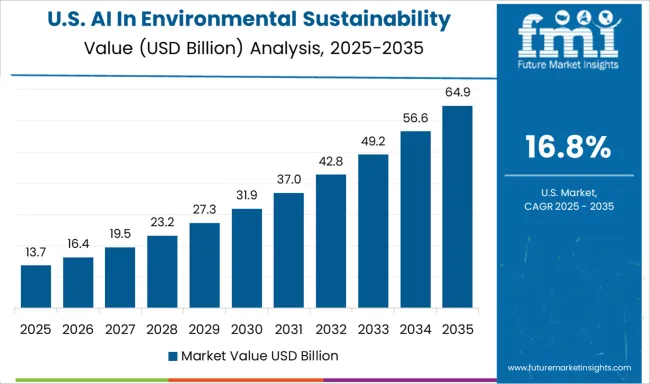
Demand for AI in environmental sustainability in the USA is expanding at a CAGR of 16.8%, driven by diverse environmental challenges, established technology leadership, and growing commercial adoption of AI solutions for sustainability optimization across multiple industries and geographic regions. Large corporations and government agencies are implementing comprehensive AI-powered sustainability programs that address climate risks, resource optimization, and environmental compliance. The market benefits from robust technology infrastructure and established AI capabilities.
Revenue from AI in environmental sustainability in Brazil is growing at a CAGR of 14.9%, driven by extensive natural resources, growing environmental awareness, and increasing adoption of AI technologies for forest monitoring, agricultural optimization, and biodiversity conservation. The country's environmental significance and agricultural importance are creating opportunities for AI-powered sustainability solutions. Companies and government agencies are developing localized applications that address specific environmental challenges and conservation needs.
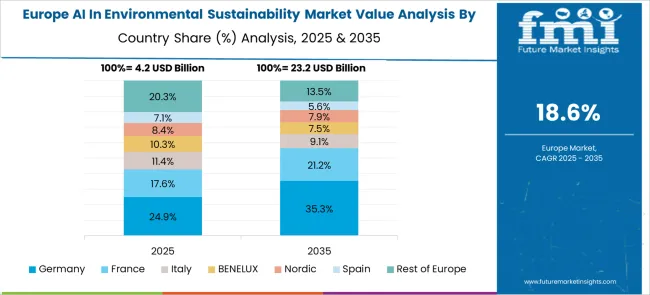
The European AI in environmental sustainability market is characterized by comprehensive environmental regulations and strong commitment to climate action that promote adoption of advanced AI technologies for sustainability applications across diverse sectors. Countries across the region maintain ambitious environmental targets and substantial funding for clean technology development that drives innovation in AI-powered environmental solutions while supporting comprehensive sustainability monitoring and optimization capabilities. The market benefits from established technology infrastructure, strong research capabilities, and extensive collaboration between government, industry, and academia that creates sustained demand for sophisticated AI environmental technologies across climate monitoring, resource optimization, and sustainable development applications.

The AI in environmental sustainability market is defined by competition among technology giants, specialized AI solution providers, and environmental technology companies offering comprehensive AI-powered sustainability solutions for diverse environmental applications and industry sectors. Companies are investing in advanced AI algorithm development, environmental data integration, platform scalability, and industry-specific applications to deliver sophisticated sustainability solutions that address complex environmental challenges while providing actionable insights for decision-making and optimization. Strategic partnerships, technology integration, and market expansion are central to strengthening solution portfolios and competitive positioning.
Major AI environmental technology companies maintain comprehensive development capabilities and extensive industry expertise that enable government agencies, corporations, and research institutions to implement optimal AI-powered sustainability solutions for diverse environmental management and climate action requirements. Microsoft, USA-based, offers comprehensive AI sustainability platforms emphasizing cloud integration and enterprise scalability across global environmental applications. Amazon Web Services Inc. provides advanced AI infrastructure and environmental analytics capabilities with focus on cloud-based sustainability solutions.
Cisco Systems Inc. delivers comprehensive IoT-AI integration for environmental monitoring and management applications. Google LLC and IBM Corporation offer sophisticated AI platforms with emphasis on environmental analytics and climate modeling capabilities. Hitachi Ltd., NVIDIA Corporation, Oracle Corporation, Schneider Electric, and Siemens provide specialized AI environmental expertise, advanced technology platforms, and comprehensive industry solutions across global and regional environmental sustainability markets.
| Items | Values |
|---|---|
| Quantitative Units | USD 19.8 billion |
| Application | Climate Change Mitigation, Renewable Energy Optimization, Waste Management, Water Resource Management, Biodiversity & Wildlife Monitoring, Precision Agriculture, Air Quality Monitoring, Natural Disaster Prediction & Response |
| Technology | Machine Learning, Computer Vision, Natural Language Processing, Predictive Analytics, Reinforcement Learning |
| End Use | Government & Public Sector, Energy & Utilities, Agriculture, Transportation & Logistics, Manufacturing |
| Regions Covered | North America, Europe, East Asia, South Asia & Pacific, Latin America, Middle East & Africa |
| Country Covered | United States, Canada, United Kingdom, Germany, France, China, Japan, South Korea, India, Brazil, Australia and 40+ countries |
| Key Companies Profiled | Microsoft; Amazon Web Services, Inc.; Cisco Systems, Inc.; Google LLC; Hitachi, Ltd.; IBM Corporation; NVIDIA Corporation; Oracle Corporation; Schneider Electric; Siemens |
| Additional Attributes | Dollar sales by application, technology, and end use, regional demand trends across North America, Europe, and Asia-Pacific, competitive landscape with established technology companies and specialized AI solution providers, adoption of advanced machine learning and predictive analytics technologies, integration with IoT sensor networks and environmental monitoring systems, innovations in comprehensive sustainability platforms and digital twin technologies, and development of industry-specific environmental AI solutions and climate action capabilities. |
The global AI in environmental sustainability market is estimated to be valued at USD 19.8 billion in 2025.
The market size for the AI in environmental sustainability market is projected to reach USD 120.8 billion by 2035.
The AI in environmental sustainability market is expected to grow at a 19.8% CAGR between 2025 and 2035.
The key product types in AI in environmental sustainability market are climate change mitigation, renewable energy optimization, waste management, water resource management, biodiversity & wildlife monitoring, precision agriculture, air quality monitoring and natural disaster prediction & response.
In terms of technology outlook, machine learning segment to command 36.2% share in the AI in environmental sustainability market in 2025.






Full Research Suite comprises of:
Market outlook & trends analysis
Interviews & case studies
Strategic recommendations
Vendor profiles & capabilities analysis
5-year forecasts
8 regions and 60+ country-level data splits
Market segment data splits
12 months of continuous data updates
DELIVERED AS:
PDF EXCEL ONLINE
AI Document Generator Market Size and Share Forecast Outlook 2025 to 2035
Air Caster Skids System Market Size and Share Forecast Outlook 2025 to 2035
AI Platform Market Size and Share Forecast Outlook 2025 to 2035
AI-Powered Sleep Technologies Market Size and Share Forecast Outlook 2025 to 2035
AI-Powered Gait & Mobility Analytics Market Size and Share Forecast Outlook 2025 to 2035
AI-Powered Behavioral Therapy Market Size and Share Forecast Outlook 2025 to 2035
AI-Enabled Behavioral Therapy Market Size and Share Forecast Outlook 2025 to 2035
Airflow Balancer Market Size and Share Forecast Outlook 2025 to 2035
AIOps Platform Market Forecast and Outlook 2025 to 2035
Aircraft Flight Control System Market Size and Share Forecast Outlook 2025 to 2035
Airborne Radar Market Size and Share Forecast Outlook 2025 to 2035
AI-Powered CRM Platform Market Forecast Outlook 2025 to 2035
AI Animation Tool Market Forecast Outlook 2025 to 2035
Aircraft Electric Motor Market Forecast Outlook 2025 to 2035
Airport Ground Transportation Market Forecast and Outlook 2025 to 2035
AI Image Editor Market Forecast and Outlook 2025 to 2035
Airless Sprayer Accessories Market Size and Share Forecast Outlook 2025 to 2035
Air Purge Valve Market Size and Share Forecast Outlook 2025 to 2035
Air Flow Sensors Market Size and Share Forecast Outlook 2025 to 2035
Air Separation Plant Market Size and Share Forecast Outlook 2025 to 2035

Thank you!
You will receive an email from our Business Development Manager. Please be sure to check your SPAM/JUNK folder too.
Chat With
MaRIA